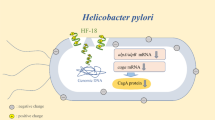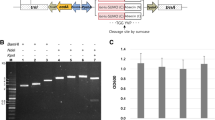Abstract
Helicobacter pylori (H. pylori) shows increasingly enhanced resistance to various antibiotics, and its eradication has become a major problem in medicine. The antimicrobial peptide PGLa-AM1 is a short peptide with 22 amino acids and exhibits strong antibacterial activity. In this study, we investigated whether it has anti-H. pylori activity for the further development of anti-H. pylori drugs to replace existing antibiotics. However, the natural antimicrobial peptide PGLa-AM1 shows a low yield and is difficult to separate, limiting its application. A good strategy to solve this problem is to express the antimicrobial peptide PGLa-AM1 using gene engineering at a high level and low cost. For getting PGLa-AM1 with native structure, in this study, a specific protease cleavage site of tobacco etch virus (TEV) was designed before the PGLa-AM1 peptide. For convenience to purify and identify high-efficiency expression PGLa-AM1, the PGLa-AM1 gene was fused with the polyhedrin gene of Bombyx mori (B. mori), and a 6 × His tag was designed to insert before the amino terminus of the fusion protein. The fusion antibacterial peptide PGLa-AM1 (FAMP) gene codon was optimized, and the gene was synthesized and cloned into the Escherichia coli (E. coli) pET-30a (+) expression vector. The results showed that the FAMP was successfully expressed in E. coli. Its molecular weight was approximately 34 kDa, and its expression level was approximately 30 mg/L. After the FAMP was purified, it was further digested with TEV protease. The acquired recombinant antimicrobial peptide PGLa-AM1 exerted strong anti-H. pylori activity and therapeutic effect in vitro and in vivo.






Similar content being viewed by others

References
Barrell PJ, Liew OW, Conner AJ (2004) Expressing an antibacterial protein in bacteria for raising antibodies. Protein Expr Purif 33:153–159. doi:10.1016/j.pep.2003.08.026
Binh TT, Shiota S, Nguyen LT, Ho DD, Hoang HH, Ta L, Trinh DT, Fujioka T, Yamaoka Y (2013) The incidence of primary antibiotic resistance of Helicobacter pylori in Vietnam. J Clin Gastroenterol 47:233–238. doi:10.1097/MCG.0b013e3182676e2b
Cheung TK, Wong BC (2008) Treatment of Helicobacter pylori and prevention of gastric cancer. J Dig Dis 9:8–13. doi:10.1111/j.1443-9573.2007.00315.x
Cheung TK, Xia HH, Wong BC (2007) Helicobacter pylori eradication for gastric cancer prevention. J Gastroenterol 42:10–15. doi:10.1007/s00535-006-1939-2
Cipáková I, Hostinová E, Gasperík J, Velebný V (2004) High-level expression and purification of a recombinant hBD-1 fused to LMM protein in Escherichia coli. Protein Expr Purif 37:207–212. doi:10.1016/j.pep.2004.04.024
Clinical and Laboratory Standards Institute (CLSI) (2016) Performance standards for antimicrobial susceptibility testing: seventeenth informational supplement. CLSI document M100- S26. CLSI, Wayne, PA, USA.
Conlon JM, Al-Ghaferi N, Ahmed E, Meetani MA, Leprince J, Nielsen PF (2010) Orthologs of magainin, PGLa, procaerulein-derived, and proxenopsin-derived peptides from skin secretions of the octoploid frog Xenopus amieti (Pipidae). Peptides 31:989–994. doi:10.1016/j.peptides
Dunn BE, Cohen H, Blaser MJ (1997) Helicobacter pylori. Clin Microbiol Rev 10:720–741
Graham DY, Fischbach L (2010) Helicobacter pylori treatment in the era of increasing antibiotic resistance. Gut 59:1143–1153. doi:10.1136/gut.2009.192757
Frenck RW, Clemens J (2003) Helicobacter in the developing world. Microbes and Infection 5:705–713
Gisbert JP, González L, Calvet X, García N, López T, Roqué M, Gabriel R, Pajares JM (2000) Proton pump inhibitor, clarithromycin and either amoxycillin or nitroimidazole: a meta-analysis of eradication of Helicobacter pylori. Aliment Pharmacol Ther 14:1319–1328
Jenssen H, Hamill P, Hancock RE (2006) Peptide antimicrobial agents. Clin Microbiol Rev 19:491–511. doi:10.1128/CMR.00056-05
Koczulla AR, Bals R (2003) Antimicrobial peptides: current status and therapeutic potential. Drugs 63:389–406
Lavallee C, Arella M, Belloncik S, Furuichi Y (1993) Expression in Escherichia coli of the cloned polyhedrin gene of Bombyx mori cytoplasmic polyhedrosis virus. Protein Expr Purif 4:570–579
Mégraud F, Lehn N, Lind T, Bayerdorffer E, O’morain C, Spiller R, Unge P, van Zanten SV, Wrangstadh M, Burman CF (1999) Antimicrobial susceptibility testing of Helicobacter pylori in a large multicenter trial: the MACH 2 study. Antimicrob Agents Chemother 43:2747–2752
Molina-Infante J, Gisbert JP (2014) Optimizing clarithromycin-containing therapy for Helicobacter pylori in the era of antibiotic resistance. World J Gastroenterol 20:10338–10347. doi:10.3748/wjg.v20.i30.10338
Morassutti C, Amicis FD, Bandiera A, Marchetti S (2005) Expression of SMAP-29 cathelicidin-like peptide in bacterial cells by intein-mediated system. Protein Expr Purif 39:160–168. doi:10.1016/j.pep.2004.11.006
Nishizawa T, Suzuki H, Suzuki M, Takahashi M, Hibi T (2012) Proton pump inhibitor- amoxicillin- clarithromycin versus proton pump inhibitor-amoxicillin-metronidazole as first-line Helicobacter pylori eradication therapy. J Clin Biochem Nutr 51:114–116. doi:10.3164/jcbn.D-11-00029R1
Rao XC, Li S, Hu JC, Jin XL, Hu XM, Huang JJ, Chen ZJ, Zhu JM, Hu FQ (2004) A novel carrier molecule for high-level expression of peptide antibiotics in Escherichia coli. Protein Expr Purif 36:11–18. doi:10.1016/j.pep.2004.01.020
Seo JH, Li L, Yeo JS, Cha HJ (2003) Baculoviral polyhedrin as a novel fusion partner for formation of inclusion body in Escherichia coli. Biotechnol Bioeng 84:467–473. doi:10.1002/bit.10798
Shiota S, Nguyen LT, Murakami K, Kuroda A, Mizukami K, Okimoto T, Kodama M, Fujioka T, Yamaoka Y (2012) Association of Helicobacter pylori dupA with the failure of primary eradication. J Clin Gastroentero l46:297–301. doi:10.1097/MCG.0b013e318243201c
Tao Y, Zhao DM, Wen Y (2014) Expression, purification and antibacterial activity of the channel catfish hepcidin mature peptide. Protein Expr Purif 94:73–78. doi:10.1016/j.pep.2013.11.001
Terpe K (2006) Overview of bacterial expression systems for heterologous protein production: from molecular and biochemical fundamentals to commercial systems. Appl Microbiol Biotechnol 72:211–222. doi:10.1007/s00253-006-0465-8
Vilaichone RK, Yamaoka Y, Shiota S, Ratanachu-ek T, Tshering L, Uchida T, Fujioka T, Mahachai V (2013) Antibiotics resistance rate of Helicobacter pylori in Bhutan. World J Gastroenterol 19:5508–5512. doi:10.3748/wjg.v19.i33.5508
Yang D, Biragyn A, Hoover DM, Lubkowski J, Oppenheim JJ (2004) Multiple roles of antimicrobial defensins, cathelicidins, and eosinophil-derived neurotoxin in host defense. Annu Rev Immunol 22:181–215
Yang D, Biragyn A, Kwak LW, Oppenheim JJ (2002) Mammalian defensins in immunity: more than just microbicidal. Trends Immunol 23:291–296
Acknowledgments
This study was funded by the major project of the Natural Science Foundation of Anhui Province Education Department (no. KJ2016SD16).
Author information
Authors and Affiliations
Corresponding authors
Ethics declarations
All procedures were conducted in accordance with the P. R. China legislation under no. 8910 M047 on the use and care of laboratory animals and with the guidelines established by the Institute for Experimental Animals of Anhui Science and Technology University and were approved by the university committee for animal experiments.
Conflict of interest
The authors declare that they have no conflicts of interest.
Rights and permissions
About this article
Cite this article
Zhang, X., Jiang, A., Wang, G. et al. Fusion expression of the PGLa-AM1 with native structure and evaluation of its anti-Helicobacter pylori activity. Appl Microbiol Biotechnol 101, 5667–5675 (2017). https://doi.org/10.1007/s00253-017-8302-9
Received:
Revised:
Accepted:
Published:
Issue Date:
DOI: https://doi.org/10.1007/s00253-017-8302-9



